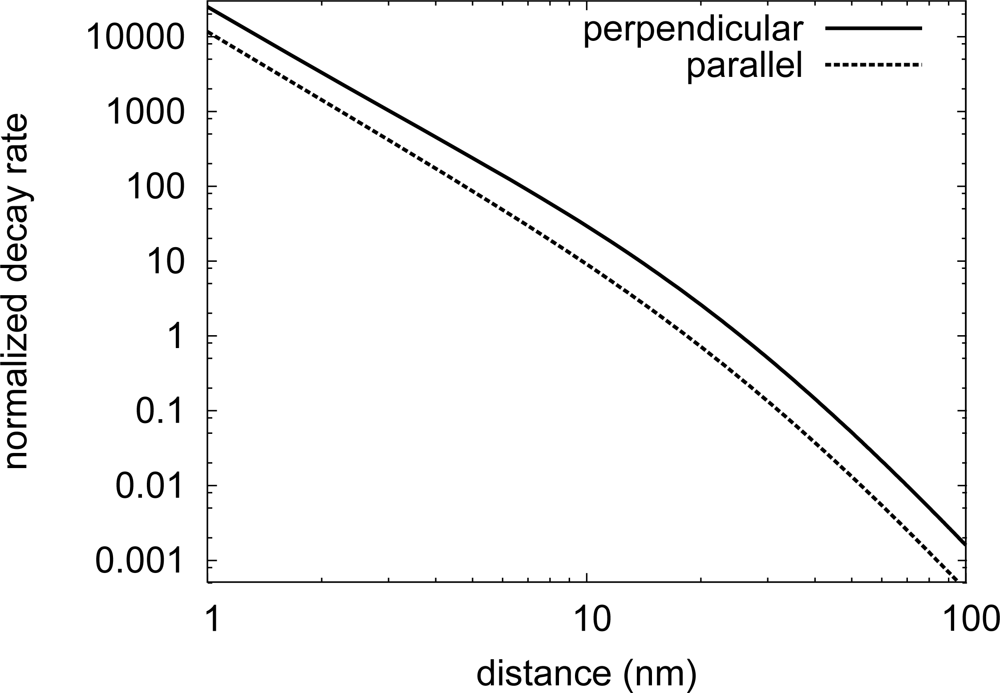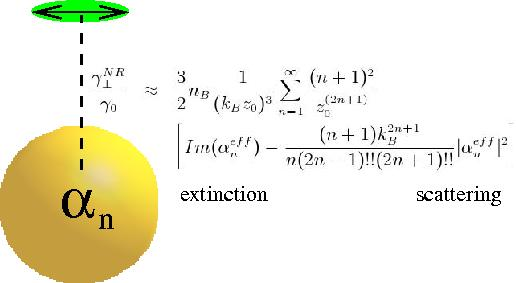Molecule Non-Radiative Coupling to a Metallic Nanosphere: An Optical Theorem Treatment
Abstract
:1. Introduction
2. Non-Radiative Coupling Rate in the Quasi-Static Regim
2.1. Expansion on Particles Modes Polarizabilities
2.2. Optical Theorem and Finite Size Corrections
3. Conclusions
Acknowledgments
References
- Gersten, J; Nitzan, A. Spectroscopic properties of molecules interacting with small dielectric particles. J. Chem. Phys 1981, 75, 1139–1152. [Google Scholar]
- Surface-Enhanced Raman Scattering–Physics and Applications; Kneipp, K; Moskovits, M; Kneipp, H (Eds.) Springer-Verlag: Berlin, Heidelberg, Gemany, 2006.
- Mertens, H; Koenderink, A; Polman, A. Plasmon-enhanced luminescence near noble-metal nanospheres: Comparison of exact theory and an improved Gersten and Nitzan model. Phys. Rev. B 2007, 76, 115123. [Google Scholar]
- Mertens, H; Polman, A. Strong luminescence quantum-efficiency enhancement near prolate metal nanoparticles: Dipolar versus higher-order modes. J. Appl. Phys 2009, 105, 044302. [Google Scholar]
- Colas des Francs, G; Bouhelier, A; Finot, E; Weeber, JC; Dereux, A; Girard, C; Dujardin, E. Fluorescence relaxation in the near-field of a mesoscopic metallic particle: Distance dependence and role of plasmon modes. Opt. Exp 2008, 16, 17654–17666. [Google Scholar]
- Colas des Francs, G; Girard, C; Juan, M; Dereux, A. Energy transfer in near-field optics. J. Chem. Phys 2005, 123, 174709. [Google Scholar]
- Baffou, G; Girard, C; Dujardin, E; Colas des Francs, G; Martin, O. Molecular quenching and relaxation in a plasmonic tunable nanogap. Phys Rev B 2008, 77, 121101(R). [Google Scholar]
- Jones, TB; Washizu,, M. Multipolar dielectrophoretic and electrorotation theory. J. Electrostatics 1996, 37, 121–134. [Google Scholar]
- Bohren, C; Huffman, D. Absorption and Scattering of Light by Small Particles; Wiley-Interscience: Malden, MA, USA, 1983. [Google Scholar]
- Jackson, J. Classical Electrodynamics, 3rd ed; John Wiley & Sons: New York, NY, USA, 1998. [Google Scholar]
- Yaghjian, A. Electric dyadic Green’s functions in the source region. Proc. IEEE 1980, 68, 248–263. [Google Scholar]
- Carminati, R; Greffet, J; Henkel, C; Vigoureux, J. Radiative and non-radiative decay of a single molecule close to a metallic nanoparticle. Opt. Com 2006, 261, 368–375. [Google Scholar]
- Draine, B. The discrete–dipole approximation and its application to interstellar graphite grains. Astrophys. J 1988, 333, 848–872. [Google Scholar]



© 2009 by the authors; licensee Molecular Diversity Preservation International, Basel, Switzerland. This article is an open-access article distributed under the terms and conditions of the Creative Commons Attribution license (http://creativecommons.org/licenses/by/3.0/).
Share and Cite
Des Francs, G.C. Molecule Non-Radiative Coupling to a Metallic Nanosphere: An Optical Theorem Treatment. Int. J. Mol. Sci. 2009, 10, 3931-3936. https://doi.org/10.3390/ijms10093931
Des Francs GC. Molecule Non-Radiative Coupling to a Metallic Nanosphere: An Optical Theorem Treatment. International Journal of Molecular Sciences. 2009; 10(9):3931-3936. https://doi.org/10.3390/ijms10093931
Chicago/Turabian StyleDes Francs, Gérard Colas. 2009. "Molecule Non-Radiative Coupling to a Metallic Nanosphere: An Optical Theorem Treatment" International Journal of Molecular Sciences 10, no. 9: 3931-3936. https://doi.org/10.3390/ijms10093931
APA StyleDes Francs, G. C. (2009). Molecule Non-Radiative Coupling to a Metallic Nanosphere: An Optical Theorem Treatment. International Journal of Molecular Sciences, 10(9), 3931-3936. https://doi.org/10.3390/ijms10093931




